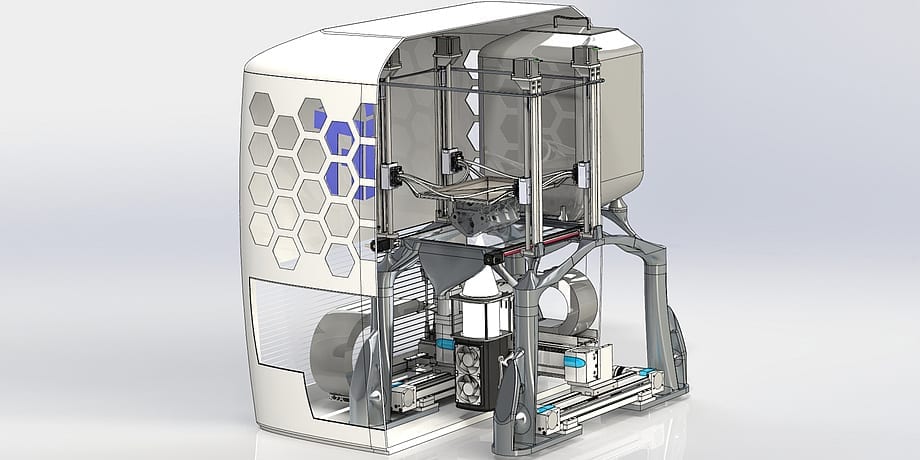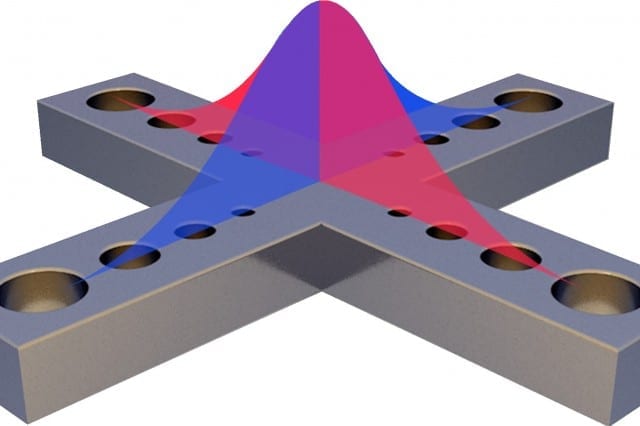
The 3D printer developed at TU Graz melts metal powder using high-performance LED light sources and then processes it into components in additive manufacturing.
via TU Graz
A technology developed at Graz University of Technology uses LED instead of laser sources for the additive manufacturing of metal parts and optimizes 3D metal printing in terms of construction time, metal powder consumption, equipment costs and post-processing effort.
Selective LED-based melting (SLEDM) – i.e. the targeted melting of metal powder using high-power LED light sources – is the name of the new technology that a team led by Franz Haas, head of the Institute of Production Engineering at TU Graz, has developed for 3D metal printing and has now applied for a patent. The technology is similar to selective laser melting (SLM) and electron beam melting (EBM), in which metal powder is melted by means of a laser or electron beam and built up into a component layer by layer. However, SLEDM solves two central problems of these powder bed-based manufacturing processes: the time-consuming production of large-volume metal components and the time-consuming manual post-processing.
Reduced production time
Unlike the SLM or EBM processes, the SLEDM process uses a high-power LED beam to melt the metal powder. The light-emitting diodes used for this purpose were specially adapted by the west Styrian lighting specialist Preworks and equipped with a complex lens system by which the diameter of the LED focus can be easily changed between 0.05 and 20 millimetres during the melting process. This enables the melting of larger volumes per unit of time without having to dispense with filigree internal structures, thus reducing the production time of components for fuel cell or medical technology, for example, by a factor of 20 on average.
Tedious reworking is no longer necessary
This technology is combined with a newly designed production plant which – in contrast to other metal melting plants – adds the component from top to bottom. The component is thus exposed, the required amount of powder is reduced to a minimum and the necessary post-processing can be carried out during the printing process. “The time-consuming, usually manual reworking that is necessary with current methods, for example, smoothing rough surfaces and removing supporting structures, is no longer necessary and saves further valuable time,” says Haas.
The Institute of Production Engineering and the Institute of Materials Science, Joining and Forming are currently working intensively on the set-up of their own additive manufacturing laboratory, the AddLab@tugraz. In Planet Research, Franz Haas tells more about the project (with video).
Fields of application and further plans
A demonstrator of the SLEDM process is already being considered in the K-Project CAMed of the Medical University of Graz, where the first laboratory for medical 3D printing was opened in October 2019. The process will be used to produce bioresorbable metal implants, i.e. preferably screws made of magnesium alloys that are used for bone fractures. These implants dissolve in the body after the fracture site has grown together. A second operation, which is often very stressful for people, is therefore no longer necessary. Thanks to SLEDM, the production of such implants would be possible directly in the operating theatre, because “an LED light is naturally less dangerous for the operation than a powerful laser source,” says Haas.
The second focus is on sustainable mobility, namely the production of components such as bipolar plates for fuel cells or components for battery systems. “We want to make additive manufacturing using SLEDM economically viable for e-mobility and position SLEDM in this field of research at an early stage,” says Haas, who will produce a marketable prototype of this 3D metal printer – “made by TU Graz” – in the next development step: a further innovation in the university environment.
The Latest Updates from Bing News & Google News
Go deeper with Bing News on:
3D metal printing
- Desktop Metal's Reactive Safety Kit enables binder jet 3D printing of titanium & aluminium materials
Users of Desktop Metal’s Production System P-1 will now be able to process reactive metals like titanium and aluminium after the company launched the Reactive Safety Kit.
- Chamlion Unveils Advanced Dental 3D Printing Solutions at IDEX 2024 Exhibition
Chamlion, a gamechanging force in the digitalization of dentistry, is set to captivate attendees at the International Dental ...
- Farsoon introduces large-format 12-laser metal 3D printer at TCT Asia
The developer of polymer laser sintering and metal laser melting systems says the FS811M features one of the biggest build volumes on the metal laser powder bed fusion market at 840 × 840 x 960mm.
- NREL Advances Sustainable Marine Energy Technology With 3D Printing
NREL researchers have partnered with the Pacific Northwest National Laboratory to explore 3D printing's potential in marine energy technology.
- Shhh! 3 Secret 3D Printing Stocks Flying Below Wall Street’s Radar
InvestorPlace - Stock Market News, Stock Advice & Trading Tips One of the best investment strategies for long-term growth is twofold: pick an ...
Go deeper with Google Headlines on:
3D metal printing
[google_news title=”” keyword=”3D metal printing” num_posts=”5″ blurb_length=”0″ show_thumb=”left”]
Go deeper with Bing News on:
Selective LED-based melting
- The Learning Network
Teach and learn with The Times: Resources for bringing the world into your classroom Have you been paying attention to current events recently? See how many of these 10 questions you can get right ...
- The LED-based BR40: A bulb begging for placement that’s drafty
The bulbs I’ve to date converted to all-BR40 LED successors had two common characteristics ... Today I learned…that you can make outrageous lifetime claims based on single diode reliability at optimum ...
- A high efficiency LED based on copper–iodide clusters
high brightness warm white light-emitting diode (LED) based on copper-iodide cluster hybrids. Their work is published in Nature Photonics. Solution-processed LED are considered to be the ...
- Pole-Mounted External Luminaires
iGuzzini's range of pole-mounted streetlights offers LED-based systems with a die-cast aluminum optical compartment with a variety of optics options. The lights have a high visual comfort with no ...
- Prospects for LED lighting
White-light sources based on reliable and energy-efficient LEDs have only recently been made possible through developments in semiconductors (Fig. 1 shows a white-light LED in action). It is ...
Go deeper with Google Headlines on:
Selective LED-based melting
[google_news title=”” keyword=”selective LED-based melting” num_posts=”5″ blurb_length=”0″ show_thumb=”left”]









